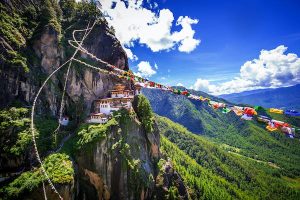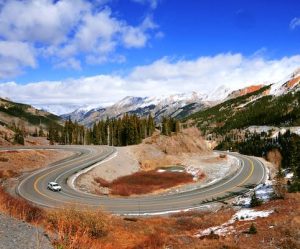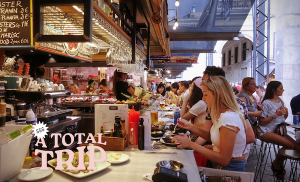
With its famously dry skies, Namibia is a wonderful destination at any time of year. The weather is almost always good – the country’s sunshine and cloudless blue skies are even highlighted on the national flag – and most attractions are accessible year-round.
However, depending on your interests, it’s worth putting some thought into the timing of your trip. Hiking is best reserved for the cooler winter months, which coincide with the northern hemisphere summer, avoiding the summertime heat. Whatever draws you to Namibia, here are the best times to visit.
Scout new ways to explore the planet’s wildest places with our weekly newsletter delivered to your inbox.
In the high season (June–October) animals can be spotted in abundance
The hallmarks of Namibia’s dry winter months are cloudless daytime skies and cold nights and the chance of rain is almost zero. Inland from the coast, daytime temperatures average between 19ºC and 24ºC (66ºF to 75ºF). In the height of winter, from June to August, nighttime temperatures in the desert and at altitude generally sit below 10ºC (50ºF) and sometimes drop below freezing.
As the high season is also the dry season, foliage is less dense, and animals congregate around scarce water sources, making this the best time of year for wildlife watching. Accordingly, safari camps fill up in Etosha National Park. Over on the coast, the shoreline is often blanketed by a thick morning fog, which generally burns off before midday.
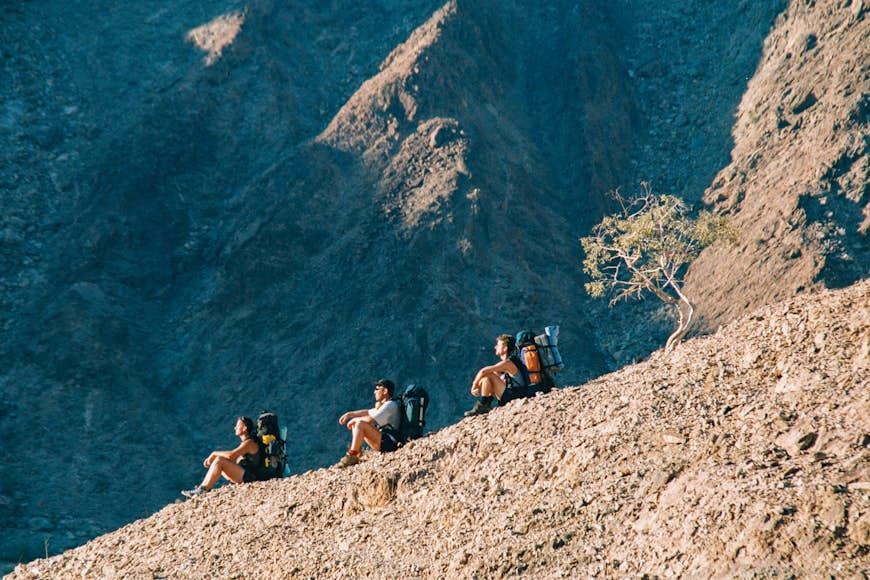 Don’t overlook the shoulder seasons when planning a trip to Namibia © wilpunt / Getty Images
Don’t overlook the shoulder seasons when planning a trip to Namibia © wilpunt / Getty Images
April, May and November are shoulder season months, with lower prices and smaller crowds
April and May are lovely times to be in Namibia, and the air is exceptionally clear. Much of Namibia is covered in shades of vivid green, and the rains have washed away the late dry-season dust. Daytime temperatures range from 24ºC to 28ºC (75ºF to 82ºF), and apart from the Easter holidays, safari camps are generally not full.
In November, daytime temperatures can pass 30ºC (86ºF) as the land eagerly awaits the rains. Wildlife watching is good, without the crowds of July and August, and lodges and camps in national parks and private reserves may offer discounted rates. Birding is also rewarding, with a multitude of migrant species.
The low-season summer months (December–March) bring rain and high temperatures
Although the summer months are the wettest time of the year in Namibia, downpours are mostly limited to late afternoons and evenings. Gravel roads, especially in the far north and in the Zambezi region, can become difficult to traverse, but otherwise, the rain does not usually interfere with travel.
In Etosha National Park, wildlife is widely dispersed and can be difficult to spot in the wet season. Temperatures are high countrywide, but especially in Namibia’s far south. In the Fish River Canyon, the mercury can soar to above 40ºC (104ºF), and the multi-day hiking trail is closed to hikers.
Along the coast, conditions are pleasant. Sea breezes bring refreshing relief from the inland heat, and it’s not as foggy as in the winter months. With the rains comes excellent birding throughout the country. During the December and January school holidays, accommodations along the central coast and in Etosha fill up, and advance booking is recommended.
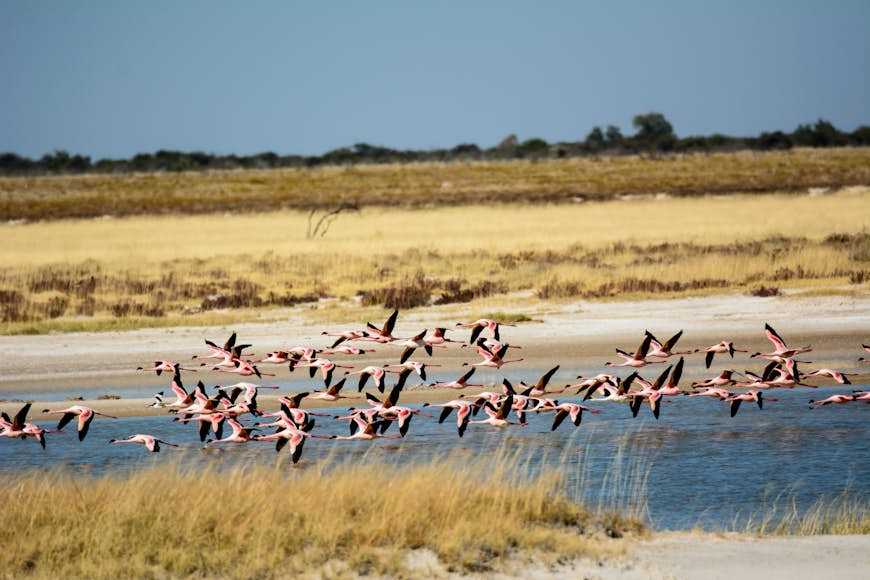 February sees flamingos gather in Etosha National Park © Trevorplatt / Getty Images
February sees flamingos gather in Etosha National Park © Trevorplatt / Getty Images
January is busy with vacationers
January is holiday time for Namibians. Accommodations in Swakopmund fill up during the first half of the month, but it’s still a fine time to explore the coast. Elsewhere, rains bring some relief from the heat, and birding is at its best.
Key events: New Year’s Day
February is green and good for birding
February is rainy and green, especially in the north. Although wildlife watching is unreliable, low-season accommodation rates and slightly discounted vehicle rental prices can make February a fine month to visit. It’s a good time for birders; flamingos gather in abundance in Etosha National Park to breed. Near the southern town of Maltahöhe, thousands of white and pink lilies bloom in February or early March, following the heavy rains.
Key events: Flamingo breeding season
March marks the end of the rains
By March, the rains have ended in most parts of the country. Skies clear up, and landscapes are green and vibrant. On March 21, Namibia celebrates its independence from South Africa; the festivities in Windhoek are especially impressive.
Key events: Independence Day
April is good for events and stargazing
April is a delightful month in Namibia, with clear, dust-free skies. With the departure of migrant birds, April is a good time for trying to spot Namibia’s endemic species, and the air is exceptionally clean. Stargazing around Windhoek and in highland areas is wonderful, and the calendar is busy with events.
Key events: Bank Windhoek Triennial Art Exhibition (organized with the National Art Gallery of Namibia), Windhoek Karneval, African Mountain Bike Championships (arranged by the Namibian Cycling Federation)
 The dry season in Namibian is a great time to spot wildlife © Ruzdi Ekenheim / Getty Images
The dry season in Namibian is a great time to spot wildlife © Ruzdi Ekenheim / Getty Images
May sees animals come out into the open
The ideal travel conditions continue in May. Toward the end of the month, the countryside starts to dry out and animals begin moving toward water sources, making late May a good time for wildlife watching. On May 4, Cassinga Day commemorates the Namibians who were killed in the 1978 Cassinga massacre.
Key events: Cassinga Day, Africa Day
June is peak time for wildlife watching
June marks the start of the wildlife watching season. June’s moderate daytime temperatures also make this an ideal month for visiting the desert landscapes of Namib-Naukluft Park and other destinations in southern Namibia.
Key events: Swakopmund Karneval (Küska)
July sees the biggest crowds
July is Namibia’s peak travel month. Relatively brief sandstorms can occur along the coast, but weather conditions are good overall. Temperatures are ideal for attempting to scale some of the enormous sand dunes in Namib-Naukluft Park. With cooler temperatures, July is also one of the best months for hiking in the Fish River Canyon.
Key events: Fish River Canyon Ultra Marathon
August sees celebrations of Namibian national identity
The high-season travel month of August is marked by warm and sometimes windy days, chilly nights and dust-filled skies, but wildlife watching remains excellent. Namibian Heroes Day on 26 August commemorates the start of the country’s war of independence, which began in Omugulugwombashe village in northern Namibia. Late August brings a major gathering of the Red Flag Herero people, who come together to commemorate their slain chiefs in Otjiwarongo, about 250km (155 miles) north of Windhoek.
Key events: Namibian Heroes Day, KinoNamibia Film Festival, Red Flag Herero Day
 September is a great time to spot Namibia’s birdlife © Ruzdi Ekenheim / Getty Images
September is a great time to spot Namibia’s birdlife © Ruzdi Ekenheim / Getty Images
September is a time for birding, singing and dancing
September brings migratory birds to Namibia, especially raptors. Temperatures are warmer, and wildlife watching and birding are both rewarding. The Lusata Cultural Festival of the Mafwe people takes place in the Zambezi region near Katima Mulilo, drawing participants from Namibia, Botswana and Zambia for spirited singing and dancing.
Key events: Mafwe Lusata Cultural Festival
October sees smaller crowds but lots of events
October’s highlights are blooming jacaranda trees and streets adorned with lavender-hued carpets of fallen blossoms. The jacaranda trees are especially lovely in Windhoek and the northern town of Tsumeb. Throughout the country, temperatures are warm but not searing, and crowds are minimal.
The /Ae //Gams Arts and Cultural Festival comes to Windhoek (though it sometimes takes place at other times of year), with dancing and musical performances. In Omaruru in central Namibia, the White Flag Herero people commemorate their slain chiefs. The best places to celebrate Oktoberfest are Windhoek and Swakopmund.
Key events: Oktoberfest, White Flag Herero Day in Omaruru, /Ae //Gams Arts and Cultural Festival
November is a quieter time for wildlife watching
November is a fine time for wildlife watching and birding, with the heavy rains yet to arrive and a full complement of migratory birds. High-season crowds at Etosha National Park have diminished, and animals can be easily spotted around water holes.
Key events: Namib Desert Ultra Marathon
December sees holiday crowds
Namibia’s summer vacation season begins in December, centered on the annual school Christmas holidays. Windhoek empties out, Etosha and the central coast fill up, and Namibians enjoy braais (barbecues), time on the farm and relaxation.
Temperatures are high inland but comfortable on the coast, and the rains are generally not too heavy. So long as you book ahead for accommodations in popular areas, December can be a delightful time to travel in Namibia.
Key events: Desert Dash Bicycle Race, Jetty Mile Ocean Swim

